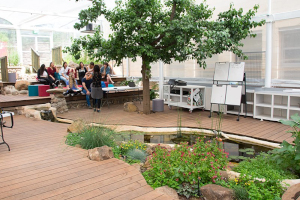Creating Space to Nurture Our Human Nature in the Built World
- < 5 Signs of Visionary Product Manufacturers and How They Avoid Extinction
- > How Risk Simulation, Uncertainty, and Randomness May Affect Building Product Manufacturers
In 1925, Henry Beston wrote The Outermost House, in which he chronicled a year spent alone on a Cape Cod beach. His solitary time revealed truths relevant to nature, including human nature. Beston said, “Nature is a part of our humanity, and without some awareness and experience of that divine mystery, man ceases to be man.” All our evolution toward a more civilized society has crippled our connection to an elemental part of the human experience. Without experiencing nature as something more than a novelty, future generations will find it hard to protect and sustain nature.
Stephen R. Kellert spent his life trying to prevent this exact problem. Kellert was a professor of social ecology at the Yale School of Forestry & Environmental Studies, and his research and publications focused on the connection between humans and the natural world. In the years leading up to his 2017 death, he helped create the concept of biophilic design. Biophilic design is an approach that seeks to fuse nature with architecture, not just inspiring natural design but specifically affecting how buildings and communities’ function. Biophilic design is influenced by Harvard professor and biologist, E. O. Wilson, who used the term to describe “the connections that human beings subconsciously seek with the rest of life”. Kellert addressed this, viewing humanities fractured relationship with nature as “a design problem rather than an unavoidable aspect of modern life”. With all our focus on sustainable buildings, nature itself is the missing link to bridge the gap between humans and the outside world. Kellert said, “We now regard keeping higher vertebrates in old-fashioned, barren cages as inhumane. We outlawed the old zoos and replaced them with exquisite reproductions of natural animal environments, but we keep humans in inhumane environments. We give them a computer with a nice screen saver and maybe a poster of a potted plant, and if (the building) is energy efficient, we call it ‘Gold’.”
A recent survey in the UK proved this disconnect to be true, showing that 69% (or 7 out of 10) Brits feel they are losing touch with nature. Some disturbing results from the survey include:
- 13% of Brits admitted that it’s been two years or more since they left urban areas and visited the countryside
- 33% of parents felt that they don’t know enough about British wildlife to pass any knowledge onto their children
- Brits surveyed couldn’t identify certain wildlife, such as owls, toads, and hedgehogs, or trees that had been known by previous generations
In America, studies show a link between employee absences and a work environment with no link to nature. Also, 20-26% of children function faster at school when learning in natural light environments, while a view of nature has proven to reduce the length of a hospital stay by over 8%.
Principles of Biophilic Design
Academia and statistics are effective at explaining the need for a connection to nature, but what exactly is Biophilic Design? Kellert created six principles to guide the incorporation of nature into the built world:
- Environmental Features—incorporating nature into the built environment through color, water, air, sunlight, plants, animals, and natural materials.
- Natural Shapes and Forms—simulates natural features through botanical, animal, and shell motifs; using arches and domes; and avoiding straight lines and right angles.
- Natural Patterns and Processes—using the natural contrasts, balance, and tension in nature to vary the sensory experience of a space, along with rhythm, ratios, and scale in conjunction with transitory light over time to emulate nature inside.
- Light and Space—Learning the how and why of the relationship between humans and light and putting this knowledge to use in the built environment.
- Place-Based Relationships—honoring the significance of place and its historical, cultural, geographic, spiritual, or ecological meaning.
- Evolved Human-Nature Relationships—using design to create reactions and connections to the long history between nature and humans.
This is important because sustainable architecture’s goal to decrease the impact of the built and design world on the environment doesn’t address the sustainability of humans. Therefore, like Kellert encouraged, this lack of connection between humans and nature can be directly addressed through the design of the built world.

Relationship Between Biophilia and Architecture
The concept of biophilia has long been understood and studied by biologists and ecologists. But it’s just been the last few decades that the world at large has been paying attention to it. Humanity’s ability to live healthy lives is being affected by our move toward an inside life. Eighty-seven percent of the average American’s life is spent indoors and 6% of their life is spent in their automobiles. As a result, and because of the tide turning to sustainable living as a holistic idea, large American companies have incorporated biophilia as a design standard.
Amazon’s Spheres opened in January 2018 at the company’s Seattle headquarters, encompassing three giant glass domes with an indoor rainforest, a river, and a 4,000sf vertical garden with 25,000 plants covering 200 species. Apple’s new headquarters, still in Cupertino, surrounds a 30-acre park, orchard, and pond. Facebook’s new headquarters, in Menlo Park, CA, includes a 9-acre rooftop park. Google’s new Chicago branch of headquarters is the newest addition to their line of biophilic workspaces spread throughout major cities in America. The Chicago location includes access to open spaces, natural light, and adjustable sunshine-simulating light to work better with the body’s natural circadian rhythms. These companies are just the beginning, as biophilia moves through the commercial industry into hospitals, education and academic architecture, and eventually to residential.
Biophilia, the WELL Standard, LEED, and Specification
In a previous blog titled “The WELL Standard: The Heart of Buildings”, I explained how the WELL Standard and LEED work alongside each other, but as of yet, there isn’t a LEED credit for using the WELL Standard. However, both LEED and WELL include opportunities to earn points through biophilia design.
LEED BD+C v4: New Construction—Designing with Nature, Biophilic Design for the Indoor Environment is a pilot credit that offers 1 possible point toward LEED certification for biophilic design. It references the 14 Patterns of Biophilic Design as explained in Kellert’s book, Biophilic Design: The Theory, Science and Practice of Bringing Buildings to Life. An in-depth look at these patterns can be found in this report from Terrapin Bright Green, while a laymen’s explanation is available in this great article from Interior Architects. With the forward movement of biophilic design, it’s not too bold to assume that LEED will eventually incorporate this pilot credit into the standard, and possible even add ways to earn more points.
The WELL Standard included the option to earn points in the original version, but sinceWELL v2.1 has been released in its pilot form, I chose to focus on how to earn points with the new version. Biophilic Design credits are found in three places under the Mind category. The first is a precondition, Mind: M02 Access to Nature, which intends to support occupant well-being by incorporating the natural environment through interior and exterior design. Assuming that precondition is met, there’s two other opportunities for earning points. Mind: M07 Restorative Spaces is worth up to two points and supports access to spaces that promote restoration and relief from mental fatigue or stress. Finally, there is Mind: M09 Enhanced Access to Nature, and this feature, worth 1 point, is intended to support access to nature beyond M02: Access to Nature by further incorporating nature through interior and exterior design, nature views and access to nearby nature.
As a manufacturer, you can see how your product fits into the biophilic design structure. Maybe your product isn’t directly related to biophilia but can be adapted or can support biophilic design in some way. Or maybe you’ve struggled to break into certain areas of the build and design industry, and with more interest in biophilic design, you now have an in! This move toward integrating nature and the built industry is only speeding up, so now is a great time to begin evaluating ways you can jump on opportunity. We offer some options to take steps toward this process. Becoming a LEED Green Associate is one way, and we offer a free LEED Prep Exam Course. We also have a plethora of informative blog posts on The Spec Shaman blog.
Have you been involved in a biophilic design project? What challenges did you encounter, or how was it easier than you expected?
For more information or to discuss the topic of this blog, please contact Brad Blank





